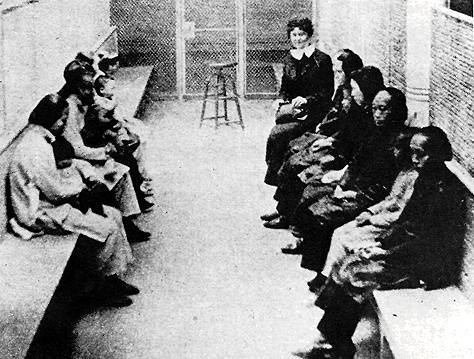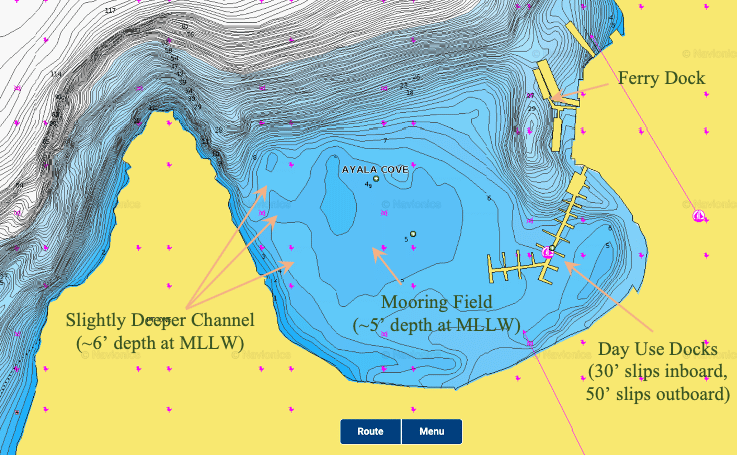ANCHORING AT AYALA COVE – WHAT YOU CAN DO AT ANGEL ISLAND STATE PARK
Imagine a beautiful Island Paradise just a few tacks away. Well, you don’t have to imagine because we have one right in the heart of San Francisco Bay not far from the Golden Gate Bridge.
It’s Angel Island State Park and one of the best anchorages on San Francisco Bay. Sailing on San Francisco Bay is majestic with views of the city, the Golden Gate Bridge and Pier 39.
If you’re looking for a day adventure where there is a public dock to berth for the day or an overnight mooring, it’s one of the most protected anchorages offering hiking, swimming and other adventures. It’s a beautiful, secluded spot to anchor at night, and you can access the island for hiking, biking, picnicking and other activities during the day.
The docks are usable from 8 am to sunset for $15. Staying on moorings for the night is allowed, but there is a small fee you pay for the privilege. Pay ahead if you can’t get to shore to pay from your boat!
HOW DO I GET A MOORING AT AYALA COVE?
Getting a mooring at Ayala Cove is a very popular activity for local boaters looking to hang out for the weekend and relax. If you want to enjoy the islands; activities during the day, be sure to bring a dinghy so you can go ashore.
Boaters can access Angel Island from Ayala Cove with their dinghy. There is a “self-pay” station if the park ranger is not there or busy. No need to wait for a park ranger to assist you with the fees. There are many kayakers exploring in the cove so keep an eye out for them to avoid accidents.
Click here to get more information for staying overnight and to book a mooring.
To get to Ayala Cove you go through Raccoon Straits. There can sometimes be very strong currents running through this area so be aware. Check tides and currents prior to departure. Ayala Cove is located on the north side of Angel Island, about 0.6 mile NE of Point Stuart. It has good anchorage in depths of 10 to 12 feet, a mud bottom, and protection from winds from the south and the west.
Angel Island mooring requires you to have two balls, a bow and stern mooring ball. You will see red and yellow labeled balls and you grab either two red or two yellow. If you want to cause a big raucous and be singled out by all the other boats at anchor, pick one yellow and one red. Not advised, though.
Bring long enough lines as the balls are about 75’ apart. You are required to moor with your bow facing northeast. Most people find that securing the stern first gives you the best control.
HOW TO PICK UP A MOORING BALL
Here is a general info on how to pick up a mooring ball to read from our partners at NauticEd.
Once anchored or docked, it’s time to enjoy the natural beauty and interesting landmarks of the island, from the historic buildings to the stunning views of Raccoon Straits, it’s an adventure you won’t soon forget. Whether you’re sailing, chartering a yacht, docking for an overnight stay, or taking the ferry for a day visit, Angel Island is sure to provide an unforgettable experience. With its long and rich history, it’s no wonder that Angel Island is one of the most popular destinations for boaters in the Bay Area.
SOME FINAL TIPS TO MAKE YOUR EXPERIENCE SAFE AND FUN
- Be aware of the tides and depth and plan your arrival and departure. Don’t get stuck in the mud! Don’t assume that there’s going to be enough water beneath your keel, Check charts, tide tables and don’t forgot to turn on your depth meter.
- Do a slow circle around the mooring area when you arrive helps greatly for setting up a game plan & keeping good communication
- Generally, you will have fairly light winds in Ayala Cove, but sometimes you will experience gusts and as it happens are usually when you have to make a bold move!
- There are strong currents in Ayala Cove so it can make maneuvering a bit extra effort and challenging.
- Make sure you bring long enough lines to use as your mooring lines. Two 3-strand lines at least 100’ is a good choice to have on board.
- This is a popular spot so arrive early! In general, do your best to arrive to new anchorages, marinas or moorings during daylight hours as it is much easier & less stressful.
- Have a boat hook ready.
Check our this link to the live cam at Ayala Cove and see what’s happening anytime.
A BIT OF HISTORY OF ANGEL ISLAND STATE PARK
How was Angel Island named? In August of 1775, Lt. Juan Manuel de Ayala arrived into San Francisco Bay and anchored in what is now called Ayala Cove. His mission was tasked with developing an accurate description of the bay and mapping it for future Spanish ship captains. He set up his work on the island and named it for the Catholic feast day closest to his discovery, which was later shortened to Isla de Los Angeles, or Angel Island.
Angel Island is a California Historical Landmark and] has been used for many purposes, including as hunting and gathering grounds for indigenous peoples, water and timber supply for European ships, cattle ranching by Mexicans, US military installations, a Public Health Services Quarantine Station, and a Bureau of Immigration inspection and detention facility.

Unfortunately, the early days of the Angel Island Immigration Station marked a dark period in American history. Immigrants and their families suffered harsh conditions and severe interrogations when they entered into the United States. There was little to no due process or protection from the law and resulted in thousands of people being detained for months on the island, and some were deported back to their homeland.
The stories of many of these immigrants remain untold, but from what we do know from remnants of information these stories serve as a stark reminder that freedom is not free, and that every new generation fights for it.
During World War II, Angel Island was used by the US military. It was a processing center and housing for servicemen waiting for deployment. It was also used as a temporary detention center for enemy aliens and prisoners of war for both German and Japanese POW’s. During the military period, the island was home to over 15,000 soldiers and their families.
By 1946 the island was de-commissioned as an immigration and military establishment and became a part of the National Park System. In 1954 it started its journey to becoming Angel Island National Park. It became a state park in the early 1960’s to preserve its cultural history and the island’s beautiful natural resources.
SERVICES AVAILABLE ON ANGEL ISLAND
Campsites
Day Use or Picnic Areas
Gear Lockers
Ice Vending
Restrooms
Enjoy the Island Cafe
Tram Rides
Hiking Trails
Boat Tours
MORE INFORMATION
Angel Island State Park – Ayala Cove Marina
Angel Island State Park Ranger Station – (415) 435-5390
Ayala Cove Kiosk – (415) 435-5390
THIS IS ONE OF A SERIES OF POSTS ON ANCHORAGES ON SAN FRANCISCO BAY. Look for our posts on anchoring at Aquatic Park, China Camp, Paradise Cay, sailing under the Golden Gate Bridge, and taking boat cruises on San Francisco Bay.

